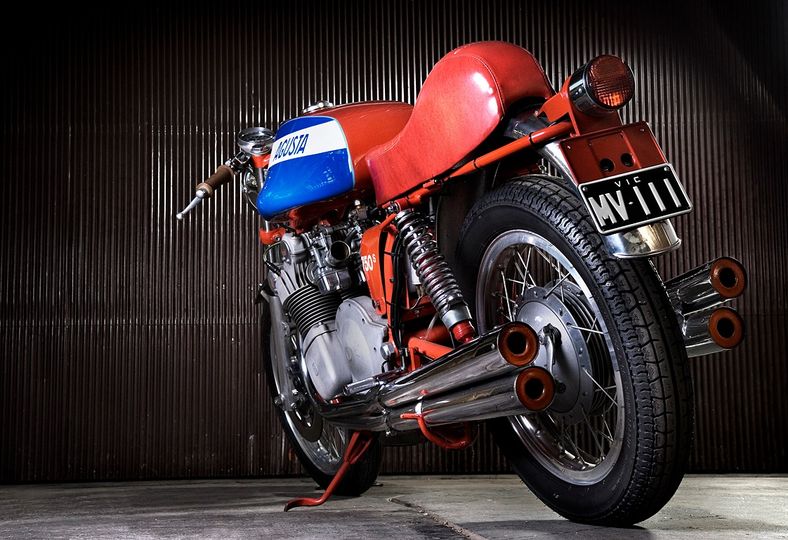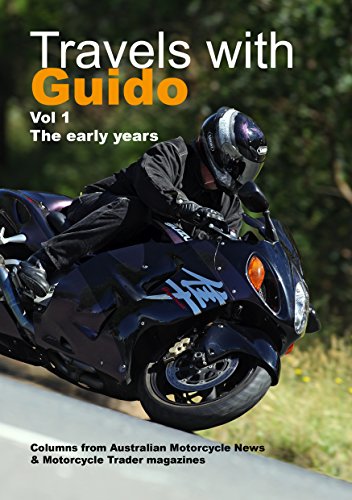Motorcycle Investor mag
Subscribe to our free email news
MV Agusta 750 S
(by Ian Falloon, Apr 2022)

The
strange development tale behind a legend
With many human
creations there is often a vintage period or vintage
year, the time when a
product represented a pinnacle of purity for design and
function. The products
of these vintage years soon earn a reputation, become
surrounded by an aura and
mystique, either justified or misguided, and are
elevated to levels beyond
their brethren. With Italian motorcycles one vintage
year was 1974.
This year saw the end
of MV Agusta’s dominance in Grand Prix racing, and the
end of pure sporting
motorcycles built without regard for legalisation and
economics. After 1974 all
motorcycles had to meet increasing noise and emission
requirements, and they
had to incorporate a left-side gearshift to be able to
be sold in the US.
No longer were
taillights small and discrete and motorcycles
unencumbered by turn signal
indicators. Carburettors had to breathe through
restrictive air cleaners and
exhausts become larger and quieter.
As manufacturers
sought to increase sales motorcycles also began to
follow trends of fashion.
Heavy cast alloy wheels replaced the wire type with
Borrani alloy rims,
electronic ignitions replaced points, and there was a
general increase in
complexity. For many, it was a downward slide as
motorcycle design was
compromised to accommodate these new requirements.
When MV Agusta
pensioned the 500cc Grand Prix four cylinder at the end
of 1965 in favour of a
new triple, the racing four was put into limited
production as the 600. Count
Agusta was determined that none of his production bikes
would challenge his racers
so the engine was enlarged, detuned, and provided with a
shaft final drive.
He was certainly
successful, and the 600 was as far removed from the race
track as could be
imagined. If any bike had a case of the uglies this was
it. A huge rectangular
headlight dominated the frontal aspect and it was slow
and heavy to boot.
But what couldn’t be
disguised was the magnificent four cylinder engine with
straight cut gears
driving the double overhead camshafts. Designed by Piero
Remor back in 1949 the
sand-cast crankcase was a one-piece casting, and the
crankshaft and big-ends
were all supported by roller bearings.
The widest part of the
MV engine was the outer cylinders and in the adaptation
to street use a
generator and electric starter were positioned at the
rear of the engine
underneath the swingarm pivot, both driven by one-way
rubber belts. The racing
design could spin safely to 9000rpm, but the carburetion
was by a pair of tiny
Dell’Orto UBF24mm carburettors more suited to a 250. The
result was an unremarkable
52 horsepower at 8200rpm, barely enough to power the
221kg 600 to 170km/h.
Count Agusta died in
1971 and without his opposition the 600 evolved into the
sporting 750 S. The
bore was increased to 65mm, retaining the 56mm stroke,
and although it retained
the small carbs the power went up to a claimed 65
horsepower.
But the 750 S was a
much more appealing piece of kit. With a large 230mm
Grimeca double sided shoe
front brake instead of the weird cable operated
Campagnolo disc brakes on the
600, and a beautifully sculptured fuel tank complemented
by a red seat, the 750
S looked the business. But it still failed to deliver.
The power claim was
unduly optimistic, and no matter how good the drum brake
looked it wasn’t
really up to the task of repeatedly slowing the heavy
MV.
All that changed for
1974 when MV decided it was time to create a real high
performance sporting
motorcycle out of the 750 S. They installed new cylinder
heads with hotter
cams, larger valves, and higher compression (10:1)
pistons. With four Dell’Orto
27mm VHB square-slide carburettors breathing through
open bell mouths, and four
virtually open mufflers the power went up to 75
horsepower at 8500 rpm.
The true essence of
the four-cylinder Grand Prix racing MV was finally
replicated. Although the
chassis was much as before a pair of 280mm Scarab discs
replaced the front drum
brake, and while not perfect they were a vast
improvement. No Italian sporting
motorcycle of the day was complete without a set of
18-inch light alloy Borrani
wheels. The only criticism that could be levelled at the
MV’s chassis was the
choice of a skinny 35mm Ceriani front fork.
The details of the MV
750 S met every expectation for a high-end product.
Weight saving didn’t really
enter into the equation so there a noticeable absence of
plastic components.
The battery covers were pressed steel, the mudguards
stainless, and the
headlight holders and instrument panel forged aluminium.
Chrome-plating
predominated and instead of a plastic steering damper
knob this was hand-knurled
aluminium.
The MV 750 S
represented the end of the pre-plastic era and it was a
motorcycle built to
last. It was also basically unaffordable and
unobtainable. Fewer than 200 were
produced and those available in Australia sold for $4700
at a time when a
Ducati 750 GT could be had for around $1500.
After 1974 MV Agusta
was lured into modifying their four for the American
market. In some respects
the next generation 750 America was superior (the 38mm
front fork was a
definite improvement) but the engine was detuned, and
fashion predominated over
function. Financial problems saw the company absorbed
into an Italian
Government conglomerate resulting in dubious matt black
paint replacing chrome
and plastic replacing aluminium. Compared to the hand
finished 750 S the
detailing on the America looked tacky.
Although the MV went
well and handled adequately the riding experience wasn’t
quite up to the
legend. This was a motorcycle dominated by the engine,
the sound of the gears
whirring and the open exhaust intoxicating. Agile
enough, due to the short
1420mm wheelbase, the weight of the shaft drive was
considerable and the 35mm
fork didn’t quite provide the surety that was evident
with a Ducati Super Sport
or Laverda SFC.
But the engine was
undoubtedly stronger than those other Italian stallions,
and the presence
exuded by the MV unequalled. The bright red, white and
blue paint and red seat
sent an unsubtle message that this was the only
motorcycle available with a 37
World Championship heritage.
-------------------------------------------------
Produced by AllMoto abn 61 400 694 722
Privacy: we do not collect cookies or any other data.

Archives
Contact





